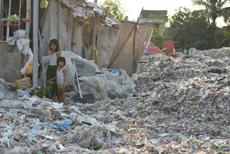 The Story of Plastic, a 95-minute documentary released on the 50th anniversary of Earth Day, takes a sweeping look at the man-made crisis of plastic pollution and the worldwide effect it has on the health of our planet and the people who inhabit it.
The Story of Plastic, a 95-minute documentary released on the 50th anniversary of Earth Day, takes a sweeping look at the man-made crisis of plastic pollution and the worldwide effect it has on the health of our planet and the people who inhabit it.
Spanning three continents, the film illustrates the ongoing catastrophe: fields full of garbage, veritable mountains of trash, rivers and seas clogged with waste, and skies choked with the poisonous emissions from plastic production and processing.
The film features interviews with experts and activists on the front lines of the fight, revealing the disastrous consequences of the flood of plastic smothering ecosystems and poisoning communities around the world, and the global movement that is rising up in response. With engaging original animation, archival industry footage beginning in the 1930s, and first-person accounts of the unfolding emergency, it distills a complex problem that is increasingly affecting the planet’s and its residents’ well-being.
Among the key takeaway points from "The Story of Plastic":
- Plastic pollution is pervasive on land and in oceans worldwide, and particularly in developing countries to which single-use plastics from the West have been shipped for recycling until recently. In so many dimensions, the plastic pollution crisis is one of environmental injustice.
- Plastic pollution is the end product of fossil fuel extraction and petrochemical production. Plastic production from the byproducts of hydraulic fracking is expected to increase dramatically as the public moves to renewable energy for electricity.
- Plastic production has been sustained and expanded over the years, despite concerns about disposal and litter, by false narratives from the industry – that disposal problems are due to bad waste management, not the product; that people are responsible for harmful plastic litter, not the producers; that plastic is not a problem because it’s recyclable; and that plastics with the chasing arrow symbol and a number are recyclable.
- Plastic pollution will not be solved by more recycling, anti-litter campaigns, or clean-ups. We need to reduce the production of plastic, especially single-use plastic and packaging, for which there are many less harmful alternatives. We need to create incentives for re-engineering products and to make producers take responsibility for the waste they generate.
View the trailer.